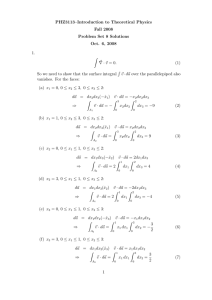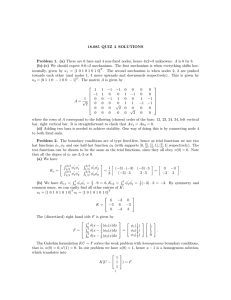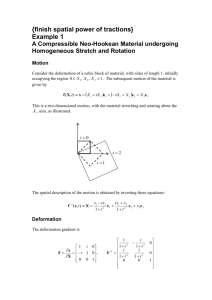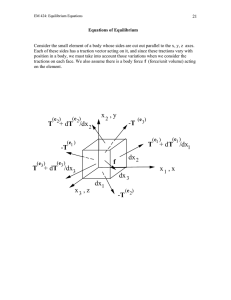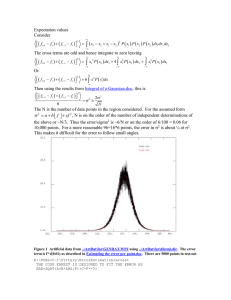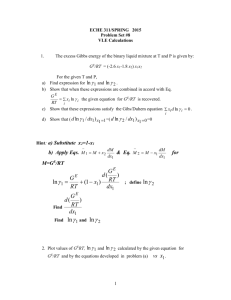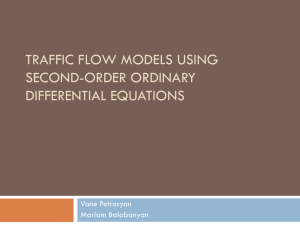Document 10773325
advertisement
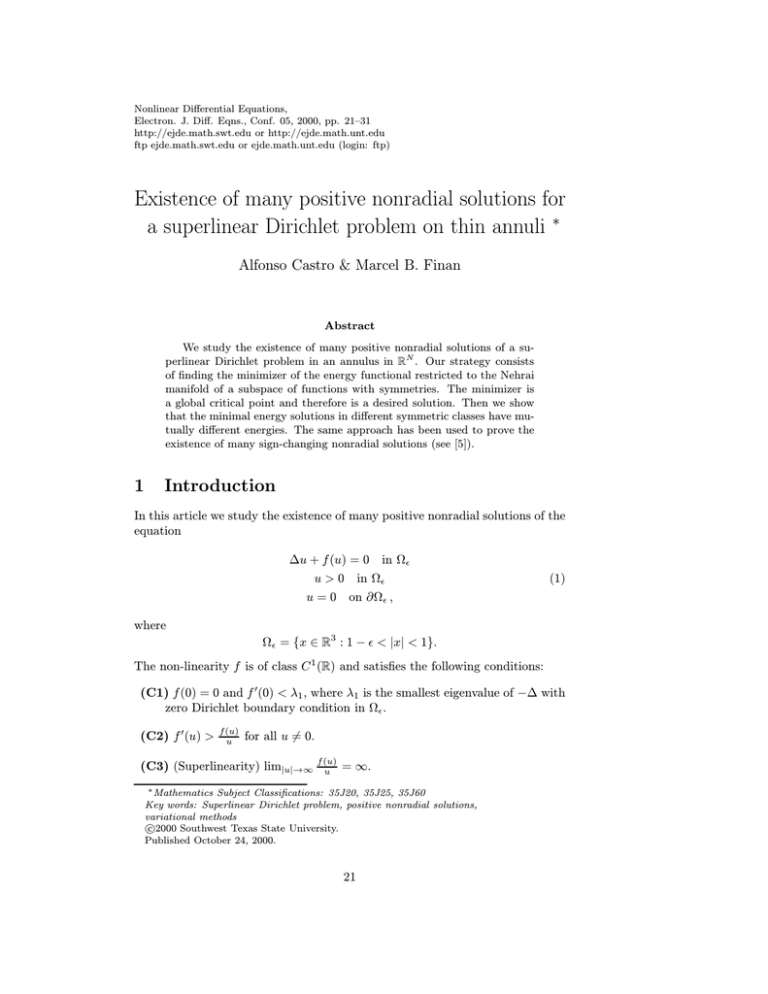
Nonlinear Differential Equations,
Electron. J. Diff. Eqns., Conf. 05, 2000, pp. 21–31
http://ejde.math.swt.edu or http://ejde.math.unt.edu
ftp ejde.math.swt.edu or ejde.math.unt.edu (login: ftp)
Existence of many positive nonradial solutions for
a superlinear Dirichlet problem on thin annuli ∗
Alfonso Castro & Marcel B. Finan
Abstract
We study the existence of many positive nonradial solutions of a superlinear Dirichlet problem in an annulus in RN . Our strategy consists
of finding the minimizer of the energy functional restricted to the Nehrai
manifold of a subspace of functions with symmetries. The minimizer is
a global critical point and therefore is a desired solution. Then we show
that the minimal energy solutions in different symmetric classes have mutually different energies. The same approach has been used to prove the
existence of many sign-changing nonradial solutions (see [5]).
1
Introduction
In this article we study the existence of many positive nonradial solutions of the
equation
∆u + f (u) = 0
in Ω
u > 0 in Ω
u = 0 on ∂Ω ,
(1)
where
Ω = {x ∈ R3 : 1 − < |x| < 1}.
The non-linearity f is of class C 1 (R) and satisfies the following conditions:
(C1) f (0) = 0 and f 0 (0) < λ1 , where λ1 is the smallest eigenvalue of −∆ with
zero Dirichlet boundary condition in Ω .
(C2) f 0 (u) >
f (u)
u
for all u 6= 0.
(C3) (Superlinearity) lim|u|→∞
f (u)
u
= ∞.
∗ Mathematics Subject Classifications: 35J20, 35J25, 35J60
Key words: Superlinear Dirichlet problem, positive nonradial solutions,
variational methods
c
2000
Southwest Texas State University.
Published October 24, 2000.
21
22
Existence of many positive nonradial solutions
(C4) (Subcritical growth) There exist constants C > 0 and p ∈ (1, 5) such
that
|f 0 (u)| ≤ C(|u|p−1 + 1), ∀u ∈ R.
(C5) There exist constants m ∈ (0, 1) and ρ such that for |u| > ρ,
uf (u) ≥
where F (u) =
Ru
0
2
F (u) > 0,
m
f (s) ds.
This paper is motivated by the work of Coffman [6], Li [7] and Lin [8]. In 1984,
Coffman showed that for f (t) = −t + tp , where p = 2N + 1, N = 2, the above
problem has many positive nonradial solutions. His result was extended by Li
N +2
[7] to the N-dimensional case with N ≥ 4 or N = 2 and for p ∈ (1, N
−2 ), when
p
the nonlinear term is λt + t for λ ≤ 0. Our main result (see Theorem 1.1
below) concerns the case N = 3. We will show that for N = 3 our problem
has many distinct nonradial solutions. We follow the strategy used in [6, 7] and
[8]. That is, we look for the minimizer of the energy functional restricted to the
Nehari manifold of a subspace of functions with symmetries. The minimizer is
a global critical point and therefore is a solution to (1). Then we show that the
minimal energy solutions in different symmetric classes has mutually different
energies.
We would like to point out here that during the preparation of this article
we were unaware of the papers by Byeon [1] and Catrina and Wang [2], where
the above problem has been solved. However, our approach is different from
theirs.
Our main result is the following
Theorem 1.1 Let conditions (C1) - (C5) be satisfied. Then, for each positive
integer k there exists 1 (k) > 0 such that if 0 < < 1 (k) then (1) has k distinct
positive nonradial solutions.
We note that our argument works for N ≥ 2 and not only for the three
dimensional case.
The approach used in proving Theorem 1.1 is similar to the one used in [7],
i.e., we consider the functionals
Z
1
|∇u|2 − F (u) dx
J(u) =
Ω 2
Z
and
γ(u) =
Ω
on
H01 (Ω ),
|∇u|2 − uf (u) dx
and for k ≥ 1, we consider the space of invariant functions
H(, k ) :=
=
Fix(Gk × {idR , −idR })
v ∈ H01 (Ω ) : v(g(x1 , x2 ), T x3 ) = v(x1 , x2 , x3 ),
Alfonso Castro & Marcel B. Finan
23
∀ (g, T ) ∈ Gk × {idR , −idR }
v ∈ H01 (Ω ) : v(x1 , x2 , x3 ) = u(x1 , x2 , |x3 |) for some u
satisfying u(g(x1 , x2 ), |x3 |) = u(x1 , x2 , |x3 |) ∀g ∈ Gk
=
where Gk = {g i : 0 ≤ i ≤ k − 1} and gz = e2πi/k z, z ∈ C ' R2 . Also, we
consider the Nehari manifold
S(, k ) = {v ∈ H(, k )\{0} : γ(v) = 0}.
Similarly, we define the space of functions
H(, ∞) := O(2) × {idR , −idR }
=
v ∈ H01 (Ω ) : v(g(x1 , x2 ), T x3 ) = v(x1 , x2 , x3 ),
∀(g, T ) ∈ O(2) × {idR , −idR }
q
=
v ∈ H01 (Ω ) : v(x1 , x2 , x3 ) = u( x21 + x22 , |x3 |), for some u ,
and the manifold
S(, ∞) = {v ∈ H(, ∞)\{0} : γ(v) = 0},
where O(2) denotes the space of 2 × 2 orthogonal matrices. Note that if u ∈
H(, ∞) then u is θ−independent.
Associated with the above sets, we consider the numbers
jk =
inf
v∈S(,k )
J(v) and j∞
=
inf
v∈S(,∞)
J(v).
We prove Theorem 1.1 by establishing the following lemmas:
Lemma 1.2 For k = 1, 2, ..., ∞, jk is achieved by some u,k ∈ S(, k ) and u,k
is a critical point of J on H(, k ).
Lemma 1.3 Let u,k be as in Lemma 1.2. Then u,k is a critical point of J on
H01 (Ω ).
Lemma 1.4 Given a positive integer k, there exists 1 (k) such that for 0 < <
1 (k) we have
jk < j∞
.
< j∞
implies jk < jkn
.
Lemma 1.5 For n = 2, 3, 4, ..., k = 1, 2, 3, ..., jkn
This article is organized as follows: In Section 2, we prove Lemmas 1.2–1.5.
In Section 3, we prove Theorem 1.1.
24
2
Existence of many positive nonradial solutions
Proof of Lemmas 1.2–1.5
Proof of Lemma 1.2: The proof follows from [3] combined with the facts that
the embeddings H(, k) ⊂ Lp (Ω ) and H(, ∞) ⊂ L∞ (Ω ) are compact (See [9])
♦
Lemma 1.3 is a result of the symmetric criticality principle: if u,k is a critical
point of J on H(, k ), then u,k is a critical point of J on H01 (Ω ) (See [9]).
To prove Lemma 1.4 we need the following results.
Lemma 2.1 (Poincaré’s inequality) Let Ω ⊂ RN be a smooth bounded domain with diameter d. Then for u ∈ H01 (Ω) we have
Z
Ω
u2 dx ≤
d2
N
Z
Ω
|∇u|2 dx .
Lemma 2.2 ([3]) 0 is a local minimum of J. If u ∈ H(, k) − {0}, then there
exists a unique α = α(u) ∈ (0, ∞) such that αu ∈ S(, k). Moreover, J(αu) =
maxλ>0 J(λu) > 0.
Lemma 2.3 ([4]) For |v| > ρ and s > 2 we have
svf (sv) ≥ Cs2/m vf (v)
for some constant C > 0.
Proof of Lemma 1.4: Let k ≥ 1 be an integer and > 0 to be chosen below.
According to Lemma 1.2, there exist u,k ∈ S(, k) and u,∞ ∈ S(, ∞) such that
jk = J(u,k ) and j∞
= J(u,∞ ). By Lemma 1.3, u,k and u,∞ are solutions to
Problem 1. Let Ωk be the set of points x = (x1 , x2 , x3 ) ≡ (r, θ, x3 ) ∈ Ω such
that θ ∈ [0, 2π/k].
Let j be a positive integer to be chosen independent of k and . Define
ω(r, θ, x3 ) =
u,∞ (r, |x3 |) sin (jkθ)
0
for θ ∈ [0, π/(jk)]
for θ ∈ [π/(jk), 2π/k] ,
where r = (x21 + x22 )1/2 . Extend ω periodically to all of Ω in the θ direction.
Let z ∈ H(, k) be the resulting extension. Since u,∞ > 0 then z > 0. By the
chain rule we have
|∇ω(r, θ, x3 )|2
=
1
(u,∞ )2 (jk)2 cos2 (jkθ)
r2
+|∇x3 u,∞ |2 sin2 (jkθ)
(u,∞ )2r sin2 (jkθ) +
if θ ∈ [0, π/(jk)], otherwise ∇ω = 0. Thus,
|∇ω(r, θ, x3 )|2 ≤ (u,∞ )2r +
1
(jk)2 (u,∞ )2 + |∇x3 u,∞ |2 .
r2
Alfonso Castro & Marcel B. Finan
25
By Lemma 2.1 we have
Z
2 Z
(diam(Ω2jk
))
u2,∞ dx1 x2 dx3 ≤
|∇u,∞ |2 dx1 x2 dx3 .
2jk
3
Ω2jk
Ω
Thus,
Z
|∇z|2 dx1 x2 dx3
Z
= k
|∇ω|2 dx1 x2 dx3
Ω
Ω2jk
Z
≤ k
Ω2jk
[(1 +
Z
≤ 2k
Z
= 2k
Ω2jk
Ω2jk
16(jk)2 2
)(u,∞ )2r + |∇x3 u,∞ |2 ] dx1 x2 dx3
27
((u,∞ )2r + |∇x3 u,∞ |2 ) dx1 x2 dx3
(2)
|∇u,∞ |2 dx1 x2 dx3
√
provided that < 3 3/(4jk). By Lemma 2.2 we can find α > 0 such that
π
π
, 2jk
]}. Suppose that
γ(αz) = 0. Let D = {(r, θ, x3 ) : u,∞ (r, |x3 |) > ρ, θ ∈ [ 4jk
√
α > 2. Then for (r, θ, x3 ) ∈ D we have α sin (jkθ) > 2. This, the fact that
tf (t) is bounded from below, say by E, and Lemma 2.3 imply
Z
αzf (αz) dx1 x2 dx3
Ω
Z
= k
α sin (jkθ)u,∞ f (α sin (jkθ)u,∞ ) dx1 x2 dx3
Ω2jk
Z
2jk
2/m
(3)
≥ k E|Ω | + Cα
u,∞ f (u,∞ ) dx1 x2 dx3
D
!
Z
Z
=
=
2/m
(
k E|Ω2jk
| + Cα
kE|Ω2jk
|
π/(2jk)
u,∞ >ρ
u,∞ f (u,∞ )r dr dx3 )(
dθ)
π/(4jk)
Z
Z π/(jk)
C 2/m
+k α
(
u,∞ f (u,∞ )r dr dx3 )(
dθ) ,
4
u,∞ >ρ
0
where |Ω | denotes the volume of Ω .
Now, let < 1/4. Then K = inf u∈S(1/4,k) J(u) ≤ inf u∈S(,k) J(u). Let u,∞
also denote the zero extension of u,∞ to all of Ω1/4 . Then u,∞ ∈ S(1/4, k).
Thus, J(u,∞ ) ≥ K and consequently
Z
|∇u,∞ |2 dx1 x2 dx3 ≥ 2K + 2M |Ω |
(4)
Ω
where M = inf {F (t) : t ∈ R}.
If we choose so that |Ω | < K/(−2M ) then (4) implies
Z
|∇u,∞ |2 dx1 dx2 dx3 ≥ K
Ω
(5)
26
Existence of many positive nonradial solutions
and this leads to
Z
u,∞ f (u,∞ )r dr dx3
u,∞ >ρ
Z
Z
=
u,∞ ≥0
=
=
≥
u,∞ f (u,∞ )r dr dx3 −
u,∞ ≤ρ
u,∞ f (u,∞ )r dr dx3
R
u f (u,∞ )r dr dx3 Z
u,∞ ≤ρ ,∞
R
1−
u,∞ f (u,∞ )r dr dx3
u f (u,∞ )r dr dx3 u,∞ ≥0
u,∞ ≥0 ,∞
R
2π u,∞ ≤ρ u,∞ f (u,∞ )r dr dx3 Z
R
1−
u,∞ f (u,∞ )r dr dx3
|∇u,∞ |2 dx1 x2 dx3
u,∞ ≥0
Ω
Z
(1 − C)
u,∞ f (u,∞ )r dr dx3
u,∞ ≥0
where the constant C is independent of (, j, k). By choosing in such a way
that 1 − C > 1/2 we conclude
Z
Z
1
u,∞ f (u,∞ )r dr dx3 >
u,∞ f (u,∞ )r dr dx3 .
2 Ω
u,∞ >ρ
This reduces (3) to
Z
Z
2jk
2/m
αzf (αz) dx1 dx2 dx3 ≥ kE|Ω | + kCα
Ω2jk
Ω
On the other hand, using (2) we have
Z
Z
αzf (αz) dx1 x2 dx3 = α2
Ω
Ω
≤
Combining (6) and (7) to obtain
Z
(Cα2/m − 2α2 )
Ω2jk
2
2kα
|∇u,∞ |2 dx1 dx2 dx3 . (6)
|∇z|2 dx1 x2 dx3
Z
Ω2jk
|∇u,∞ |2 dx1 x2 dx3 .
|∇u,∞ |2 dx1 x2 dx3 ≤
(7)
C
jk
Hence,
Cα2/m − 2α2
C/(jk)
|∇u,∞ |2 dx1 x2 dx3
Ω2jk
≤
R
≤
R
C
≤ M1 ,
|∇u
|2 dx1 x2 dx3
,∞
Ω
where we have used (5). But the function g(α) = Cα2/m − 2α2 satisfies g(0) = 0
and limα→∞ g(α) = +∞. Thus, if g(α) ≤ M1 then there is a constant K 0 such
that α ≤ K 0 . By letting
√
2, K 0 ≡ K 00
(8)
α ≤ max
Alfonso Castro & Marcel B. Finan
27
we conclude that α is bounded. Let w = αz ∈ S(, k). Since F (t) is bounded
from below, say by M , then (8) and (2) imply
Z |∇w|2
− F (w) dx1 x2 dx3
J(w) =
2
Ω
Z
Z
α2 |∇z|2
dx1 x2 dx3 −
=
F (w) dx1 x2 dx3
2
Ω
Ω
Z
|∇u,∞ |2
dx1 x2 dx3 − kM |Ω2jk
≤ 2(K 00 )2 k
|
2
Ω2jk
Z
kC
(K 00 )2
|u,∞ |2
dx1 x2 dx3 +
≤ 2
j
2
jk
Ω
Z
00 2 Z
2
(K )
1
|∇u,∞ |
|∇u,∞ |2
dx1 x2 dx3 +
dx1 x2 dx3
≤
j
2
j Ω
2
Ω
Z
C
|∇u,∞ |2
dx1 x2 dx3
≤
(9)
j Ω
2
where we have used (4) with chosen in such a way that C < K and |Ω | <
K/(−2M ). We claim that there exists a constant C such that
Z
|∇u,∞ |2
dx1 x2 dx3 ≤ CJ(u,∞ ).
2
Ω
Indeed, since γ(u,∞ ) = 0 and by (C5) we have
Z
u,∞ f (u,∞ ) dx1 x2 dx3
Ω
Z
=
|∇u,∞ |2 dx1 x2 dx3
Ω
Z
Z
2
=
(|∇u,∞ | − 2F (u,∞ )) dx1 x2 dx3 + 2
F (u,∞ ) dx1 x2 dx3
Ω
Ω
Z
m
≤ 2(J(u,∞ ) +
u,∞ f (u,∞ ) dx1 x2 dx3 + C|Ω |).
2 Ω
It follows that
(1 − m)
Z
Ω
u,∞ f (u,∞ ) dx1 x2 dx3 ≤ 2(J(u,∞ ) + C|Ω |).
On the other hand, using (4) and (C5) we have
Z
1
J(u,∞ ) =
( |∇u,∞ |2 − F (u,∞ )) dx1 x2 dx3
2
Ω
Z
1−m
)
≥ (
u,∞ f (u,∞ ) dx1 x2 dx3 − C 0 |Ω |
2
Ω
1−m
)K − C 0 |Ω |.
≥ (
2
(10)
28
Existence of many positive nonradial solutions
By choosing in such a way that C 0 |Ω | < 14 (1 − m)K, we see that J(u,∞ ) >
1−m
( 1−m
4 )K. Now, we choose such that C|Ω | < ( 4 )K. Using this in (10) we
obtain
Z
u,∞ f (u,∞ ) dx1 x2 dx3 ≤ CJ(u,∞ ).
Ω
Also, using this in (9) we obtain
C
J(u,∞ ).
j
J(w) ≤
Choosing j such that j > 2C we obtain J(w) < J(u,∞ ) and this concludes the
present proof.
♦
To prove Lemma 1.5 we need
Lemma 2.4 Let v ∈ H01 (Ω ). Then the function
Pv (λ) =
λvf (λv)
− F (λv)
2
is increasing on (0, ∞).
Proof. Differentiating P − v with respect to λ we find
λv 2
f (λv)
0
0
Pv (λ) =
f (λv) −
> 0,
2
λv
where we have used (C2). This completes the proof
♦
Proof of Lemma 1.5: Fix k and n. Let 0 < < 1 (kn). Lemma 1.2 guarantees
the existence of a minimizer u,kn of J on S(, kn). From Lemma 1.3 we see
that u,kn is a solution to (1). Furthermore, from Lemma 1.4 we know that
u,kn is nonradial. Now, by the regularity theory of elliptic equations we know
that u,kn is a C 2 function. Let x = (r, θ) be the polar coordinates of x ∈ R2
and write u = u,kn (r, θ, |x3 |). Then
Z 2π
Z
Z
1
|∇u|2 dx1 x2 dx3 =
(u2r + 2 u2θ + |∇x3 u|2 )r dr dθ dx3
r
Ω
(r,|x3 |) 0
and
Z
Ω
Z
Z
F (u) dx1 x2 dx3 =
(r,|x3 |)
0
2π
F (u)r dr dθ dx3 .
Define the function
v(r, θ, |x3 |) = u(r,
θ
, |x3 |),
n
0 ≤ θ ≤ 2π.
Then
v(r, θ +
2π
, |x3 |) =
k
=
=
2π
θ
+
, |x3 |)
n kn
θ
u(r, , |x3 |)
n
v(r, θ, |x3 |).
u(r,
Alfonso Castro & Marcel B. Finan
29
It follows that v ∈ H(, k). On the other hand, it is easy to check that the
following equalities hold
θ
, |x3 |) ,
n
1
θ
vθ (r, θ, |x3 |) = uθ (r, , |x3 |) ,
n
n
θ
∇x3 v(r, θ, |x3 |) = ∇x3 u(r, , |x3 |).
n
vr (r, θ, |x3 |) = ur (r,
Therefore,
Z
|∇v|2 dx1 x2 dx3
Z
Z
=
2π/k
k
Ω
(r,|x3 |)
0
(u2r (r,
θ
1
θ
, |x3 |) + 2 2 u2θ (r, , |x3 |)
n
r n
n
θ
+|∇x3 u(r, , |x3 |)|2 )r dr dθ dx3
n
2π
Z nk
1
kn
(u2r (r, θ, |x3 |) + 2 4 u2θ (r, θ, |x3 |)
r n
0
2
+|∇x3 u(r, θ, |x3 |)| )r dr dθ dx3
Z 2π
Z
1
(u2r (r, θ, |x3 |) + 2 4 u2θ (r, θ, |x3 |)
r n
(r,|x3 |) 0
=
=
+|∇x3 u(r, θ, |x3 |)|2 )r dr dθ dx3 .
Also
Z
Ω
Z
Z
F (v) dx1 x2 dx3
2π/k
= k
F (u(r,
Z
(r,|x3 |)
0
2π
Z
=
(r,|x3 |)
0
θ
, |x3 |))r dr dθ dx3
n
F (u(r, θ, |x3 |))r dr dθ dx3 .
Since u does not belong to S(, ∞) we have
Z
Z 2π
u2θ (r, θ, |x3 |)r dr dθdx3 > 0 .
(r,|x3 |)
It follows that
Z
γ(v) =
Ω
0
(|∇v|2 − vf (v)) dx1 x2 dx3
Z
Z
=
(r,|x3 |)
<
=
0
2π
(u2r (r, θ, |x3 |) +
1 2
u (r, θ, |x3 |)
r 2 n4 θ
+|∇x3 u(r, θ, |x3 |)|2 − uf (u))r dr dθ dx3
Z 2π
Z
1
(u2r (r, θ, |x3 |) + 2 u2θ (r, θ, |x3 |)
r
(r,|x3 |) 0
+|∇x3 u(r, θ, |x3 |)|2 − uf (u))r dr dθ dx3
Z
(|∇u|2 − uf (u)) dx1 x2 dx3 = 0.
Ω
30
Existence of many positive nonradial solutions
This yields
Z
Ω
|∇v|2 dx1 x2 dx3 <
Z
Ω
vf (v) dx1 x2 dx3 .
(11)
Now, by Lemma 2.2 we can find 0 < α < 1 such that αv ∈ S(, k). Let
w = αv ∈ S(, k). Using Lemma 2.4 and the definition of jk we have
jk
≤ J(w) = J(αv) = Pv (α)
< Pv (1)
Z
1
( vf (v) − F (v)) dx1 x2 dx3
=
2
Ω
Z 1
=
( uf (u) − F (u)) dx1 x2 dx3
2
Ω
= J(u) = jkn
.
Putting together all the arguments above we conclude a proof of the lemma ♦
3
Proof of Main Theorem
For any integer k ≥ 1, according to Lemma 1.4 there exists 1 (2k ) such that if
0 < < 1 (2k ) then
j2k < j∞
.
It follows from Lemma 1.5 that
j2 < j22 < ... < j2k < j∞
.
(12)
According to Lemma 1.2, there exists u,i ∈ S(, i), i = 1, ..., k, such that
j2i = J(u,i ).
Moreover, by Lemma 1.3 u,i is a solution of Problem 1, i = 1, . . . , k. By
(12), {u,i}ki=1 , are nonrotationally equivalent and nonradial. This completes
the proof of the theorem.
♦
References
[1] J. Byeon, Existence of many nonequivalent nonradial positive solutions of
semilinear elliptic equations on three dimensional annuli, J. Differential
Equations, Vol. 136 (1997), 136–165.
[2] F. Catrina and Z.Q. Wang, Nonlinear elliptic equations on expanding symmetric domains, to appear in J. Differential Equations.
[3] A. Castro, J. Cossio and J.M.Neuberger,A sign changing solution for a
superlinear Dirichlet Problem, Rocky Mountain J. Math. 27 (1997), 1041–
1053.
Alfonso Castro & Marcel B. Finan
31
[4] A. Castro, J. Cossio and J.M. Neuberger, A minmax principle, index of the
critical point, and existence of sign-changing solutions to elliptic boundary
value problems, Electron. J. Differential Equations, Vol. 1998 (1998), N0.2,
1–18.
[5] A. Castro and M.B. Finan, Existence of many sign-changing nonradial
solutions for a superlinear Dirichlet problem on thin annuli, Topological
Methods in Nonlinear Analysis Vol. 13, No.2 (1999), 273–279
[6] C.V. Coffman, A nonlinear boundary value problem with many positive solutions, J. Differential Equations 54 (1984), 429–437.
[7] Y.Y. Li, Existence of many positive solutions of semilinear elliptic equations
on an annulus, J. Differential Equations 83 (1990), 348–367.
[8] S.S. Lin, Existence of many positive nonradial solutions for nonlinear elliptic equations on an annulus, J. Differential Equations 103 (1993), 338–349.
[9] M. Willem, Minimax Theorems, Birkhäuser, 1996.
Alfonso Castro
Division of Mathematics and Statistics
University of Texas at San Antonio
San Antonio, TX 78249 USA.
e-mail: castro@math.utsa.edu
Marcel B. Finan
Department of Mathematics
The University of Texas at Austin
Austin, TX 78712 USA.
e-mail: mbfinan@math.utexas.edu
